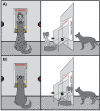Audience effect on domestic dogs' behavioural displays and facial expressions
- PMID: 35697913
- PMCID: PMC9192729
- DOI: 10.1038/s41598-022-13566-7
Audience effect on domestic dogs' behavioural displays and facial expressions
Abstract
In the present study we investigated the influence of positive and negative arousal situations and the presence of an audience on dogs' behavioural displays and facial expressions. We exposed dogs to positive anticipation, non-social frustration and social frustration evoking test sessions and measured pre and post-test salivary cortisol concentrations. Cortisol concentration did not increase during the tests and there was no difference in pre or post-test concentrations in the different test conditions, excluding a different level of arousal. Displacement behaviours of "looking away" and "sniffing the environment" occurred more in the frustration-evoking situations compared to the positive anticipation and were correlated with cortisol concentrations. "Ears forward" occurred more in the positive anticipation condition compared to the frustration-evoking conditions, was positively influenced by the presence of an audience, and negatively correlated to the pre-test cortisol concentrations, suggesting it may be a good indicator of dogs' level of attention. "Ears flattener", "blink", "nose lick", "tail wagging" and "whining" were associated with the presence of an audience but were not correlated to cortisol concentrations, suggesting a communicative component of these visual displays. These findings are a first step to systematically test which subtle cues could be considered communicative signals in domestic dogs.
© 2022. The Author(s).
Conflict of interest statement
The authors declare no competing interests.
Figures



References
-
- Wilson EO. Sociobiology: The New Synthesis. Belknap Press of Harvard University Press; 1975.
-
- Townsend SW, Koski SE, Byrne RW, Slocombe KE, Bickel B, Boeckle M, Goncalves IB, Burkart JM, Flower T, Gaunet F, Glock HJ, Gruber T, Jansen DAWAM, Liebal K, Linke A, Miklósi Á, Moore R, van Schaik CP, Stoll S, Vail A, Waller BM, Wild M, Zuberbühler K, Manser MB. Exorcising Grice’s ghost: An empirical approach to studying intentional communication in animals. Biol. Rev. 2017;92(3):1427–1433. doi: 10.1111/brv.12289. - DOI - PubMed
Publication types
MeSH terms
Substances
LinkOut - more resources
Full Text Sources

